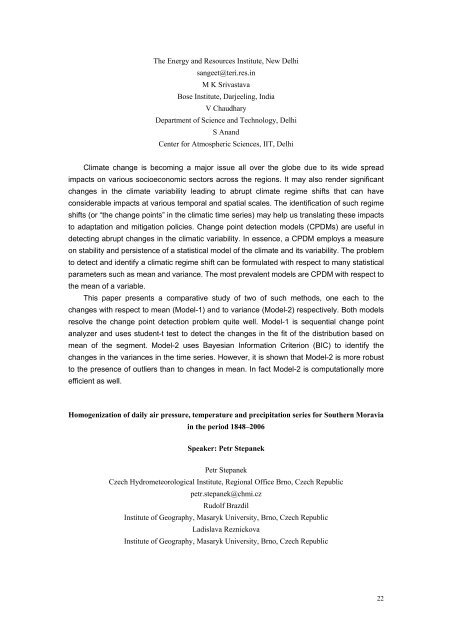The tenth IMSC, Beijing, China, 2007 - International Meetings on ...
The tenth IMSC, Beijing, China, 2007 - International Meetings on ...
The tenth IMSC, Beijing, China, 2007 - International Meetings on ...
You also want an ePaper? Increase the reach of your titles
YUMPU automatically turns print PDFs into web optimized ePapers that Google loves.
<str<strong>on</strong>g>The</str<strong>on</strong>g> Energy and Resources Institute, New Delhi<br />
sangeet@teri.res.in<br />
M K Srivastava<br />
Bose Institute, Darjeeling, India<br />
V Chaudhary<br />
Department of Science and Technology, Delhi<br />
S Anand<br />
Center for Atmospheric Sciences, IIT, Delhi<br />
Climate change is becoming a major issue all over the globe due to its wide spread<br />
impacts <strong>on</strong> various socioec<strong>on</strong>omic sectors across the regi<strong>on</strong>s. It may also render significant<br />
changes in the climate variability leading to abrupt climate regime shifts that can have<br />
c<strong>on</strong>siderable impacts at various temporal and spatial scales. <str<strong>on</strong>g>The</str<strong>on</strong>g> identificati<strong>on</strong> of such regime<br />
shifts (or “the change points” in the climatic time series) may help us translating these impacts<br />
to adaptati<strong>on</strong> and mitigati<strong>on</strong> policies. Change point detecti<strong>on</strong> models (CPDMs) are useful in<br />
detecting abrupt changes in the climatic variability. In essence, a CPDM employs a measure<br />
<strong>on</strong> stability and persistence of a statistical model of the climate and its variability. <str<strong>on</strong>g>The</str<strong>on</strong>g> problem<br />
to detect and identify a climatic regime shift can be formulated with respect to many statistical<br />
parameters such as mean and variance. <str<strong>on</strong>g>The</str<strong>on</strong>g> most prevalent models are CPDM with respect to<br />
the mean of a variable.<br />
This paper presents a comparative study of two of such methods, <strong>on</strong>e each to the<br />
changes with respect to mean (Model-1) and to variance (Model-2) respectively. Both models<br />
resolve the change point detecti<strong>on</strong> problem quite well. Model-1 is sequential change point<br />
analyzer and uses student-t test to detect the changes in the fit of the distributi<strong>on</strong> based <strong>on</strong><br />
mean of the segment. Model-2 uses Bayesian Informati<strong>on</strong> Criteri<strong>on</strong> (BIC) to identify the<br />
changes in the variances in the time series. However, it is shown that Model-2 is more robust<br />
to the presence of outliers than to changes in mean. In fact Model-2 is computati<strong>on</strong>ally more<br />
efficient as well.<br />
Homogenizati<strong>on</strong> of daily air pressure, temperature and precipitati<strong>on</strong> series for Southern Moravia<br />
in the period 1848–2006<br />
Speaker: Petr Stepanek<br />
Petr Stepanek<br />
Czech Hydrometeorological Institute, Regi<strong>on</strong>al Office Brno, Czech Republic<br />
petr.stepanek@chmi.cz<br />
Rudolf Brazdil<br />
Institute of Geography, Masaryk University, Brno, Czech Republic<br />
Ladislava Reznickova<br />
Institute of Geography, Masaryk University, Brno, Czech Republic<br />
22






![final_program_abstracts[1]](https://img.yumpu.com/19102520/1/174x260/final-program-abstracts1.jpg?quality=85)









